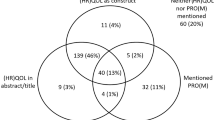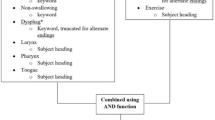Abstract
The Dysphagia Handicap Index (DHI) is a valid Health-related Quality of Life (HRQoL) 25-item questionnaire assessing the physical, functional, and emotional aspects of patients with oropharyngeal dysphagia (OD), of heterogeneous etiologies. The purpose of this study is to translate and validate the European Portuguese-DHI (EP-DHI). This is a prospective study that was carried out at Centro Hospitalar Universitário do Porto (CHUPorto). The generated EP-DHI was administered to 132 patients with OD and 112 healthy control subjects. 132 patients undergoing fiberoptic endoscopic examination of swallowing (FEES). 15 patients were contacted by phone, 2 or 3 weeks later after the first interview to repeat the questionnaire. The validity of concurrent criteria was evaluated by comparing the results of the EP-DHI score with the score attributed to the pathological findings found in FEES and, consequently, Functional Oral Intake Scale (FOIS). The internal consistency of EP-DHI was successful: Cronbach’s alpha coefficient for total EP-DHI was 0.874. The test–retest reliability for the total and the three EP-DHI subscales obtained a Pearson's correlation coefficient ranged from 0.990 to 0.712. This study demonstrates that EP-DHI is a valid tool for self-assessment of the handicapping effect of dysphagia on physical, functional, and emotional aspects of patient’s quality of life, among an European Portuguese sample.
Similar content being viewed by others
References
Murray J, Langmore SE, Ginsberg S, Dostie A. The significance of accumulated oropharyngeal secretions and swallowing frequency in predicting aspiration. Dysphagia. 1996;11(2):99–103. https://doi.org/10.1007/BF00417898.
Abdel-Jalil AA, Katzka DA, Castell DO. Approach to the patient with dysphagia. Am J Med. 2015;128(10):1138.e17-1138.e23. https://doi.org/10.1016/j.amjmed.2015.04.026.
Daniels SK, Schroeder MF, DeGeorge PC, Corey DM, Foundas AL, Rosenbek JC. Defining and measuring dysphagia following stroke. Am J Speech Lang Pathol. 2009;18(1):74–81. https://doi.org/10.1044/1058-0360(2008/07-0040).
Martino R, Foley N, Bhogal S, Diamant N, Speechley M, Teasell R. Dysphagia after stroke: incidence, diagnosis, and pulmonary complications. Stroke. 2005;36(12):2756–63. https://doi.org/10.1161/01.STR.0000190056.76543.eb.
O’Neill AC, Richter GT. Pharyngeal dysphagia in children with Down syndrome. Otolaryngol Head Neck Surg Off J Am Acad Otolaryngol Head Neck Surg. 2013;149(1):146–50. https://doi.org/10.1177/0194599813483445.
King SN, Dunlap NE, Tennant PA, Pitts T. Pathophysiology of radiation-induced dysphagia in head and neck cancer. Dysphagia. 2016;31(3):339–51. https://doi.org/10.1007/s00455-016-9710-1.
Suttrup I, Warnecke T. Dysphagia in Parkinson’s disease. Dysphagia. 2016;31(1):24–32. https://doi.org/10.1007/s00455-015-9671-9.
Groher ME, Crary MA. Dysphagia: clinical management in adults and children. Amsterdam: Elsevier; 2015. https://doi.org/10.1016/C2012-0-06096-6.
Bhattacharyya N. The prevalence of dysphagia among adults in the United States. Otolaryngol Head Neck Surg (United States). 2014;151(5):765–9. https://doi.org/10.1177/0194599814549156.
Clavé P, Shaker R. Dysphagia: current reality and scope of the problem. Nat Rev Gastroenterol Hepatol. 2015;12(5):259–70. https://doi.org/10.1038/nrgastro.2015.49.
Holland G, Jayasekeran V, Pendleton N, Horan M, Jones M, Hamdy S. Prevalence and symptom profiling of oropharyngeal dysphagia in a community dwelling of an elderly population: a self-reporting questionnaire survey. Dis Esophagus Off J Int Soc Dis Esophagus. 2011;24(7):476–80. https://doi.org/10.1111/j.1442-2050.2011.01182.x.
Patel DA, Kavitt RT, Vaezi MF. Evaluation and management of dysphagia: an evidence-based approach. Berlin: Springer; 2019. https://doi.org/10.1007/978-3-030-26554-0.
García-Peris P, et al. Long-term prevalence of oropharyngeal dysphagia in head and neck cancer patients: impact on quality of life. Clin Nutr. 2007;26(6):710–7. https://doi.org/10.1016/j.clnu.2007.08.006.
Nguyen NP, et al. Impact of dysphagia on quality of life after treatment of head-and-neck cancer. Int J Radiat Oncol Biol Phys. 2005;61(3):772–8. https://doi.org/10.1016/j.ijrobp.2004.06.017.
Campbell BH, Spinelli K, Marbella AM, Myers KB, Kuhn JC, Layde PM. Aspiration, weight loss, and quality of life in head and neck cancer survivors. Arch Otolaryngol Head Neck Surg. 2004;130(9):1100–3. https://doi.org/10.1001/archotol.130.9.1100.
Ekberg O, Hamdy S, Woisard V, Wuttge-Hannig A, Ortega P. Social and psychological burden of dysphagia: its impact on diagnosis and treatment. Dysphagia. 2002;17(2):139–46. https://doi.org/10.1007/s00455-001-0113-5.
Higginson IJ, Carr AJ. Measuring quality of life: using quality of life measures in the clinical setting. BMJ. 2001;322(7297):1297–300. https://doi.org/10.1136/bmj.322.7297.1297.
Timmerman AA, Speyer R, Heijnen BJ, Klijn-Zwijnenberg IR. Psychometric characteristics of health-related quality-of-life questionnaires in oropharyngeal dysphagia. Dysphagia. 2014;29(2):183–98. https://doi.org/10.1007/s00455-013-9511-8.
Chen AY, et al. The development and validation of a dysphagia-specific quality-of-life questionnaire for patients with head and neck cancer: the M. D. Anderson dysphagia inventory. Arch Otolaryngol Head Neck Surg. 2001;127(7):870–6.
Gustafsson B, Tibbling L. Dysphagia, an unrecognized handicap. Dysphagia. 1991;6(4):193–9.
McHorney CA, et al. The SWAL-QOL and SWAL-CARE outcomes tool for oropharyngeal dysphagia in adults: III. Documentation of reliability and validity. Dysphagia. 2002;17(2):97–114. https://doi.org/10.1007/s00455-001-0109-1.
Silbergleit AK, Schultz L, Jacobson BH, Beardsley T, Johnson AF. The dysphagia handicap index: development and validation. Dysphagia. 2012;27(1):46–52. https://doi.org/10.1007/s00455-011-9336-2.
Vieira D, Antunes EB. Clinical characteristics of dysphagia-related quality of life questionnaires. Rev Investig Logop. 2017;7(2):157–88.
Beaton D, Bombardier C, Guillemin F, Ferraz M. Recommendations for the cross-cultural adaptation of health status measures. Am Acad Orthop Surg. 1998;12:1–27.
Crary MA, Mann GDC, Groher ME. Initial psychometric assessment of a functional oral intake scale for dysphagia in stroke patients. Arch Phys Med Rehabil. 2005;86(8):1516–20. https://doi.org/10.1016/j.apmr.2004.11.049.
Christiaanse ME, Mabe B, Russell G, Simeone TL, Fortunato J, Rubin B. Neuromuscular electrical stimulation is no more effective than usual care for the treatment of primary dysphagia in children. Pediatr Pulmonol. 2011;46(6):559–65. https://doi.org/10.1002/ppul.21400.
Athukorala RP, Jones RD, Sella O, Huckabee M-L. Skill training for swallowing rehabilitation in patients with Parkinson’s disease. Arch Phys Med Rehabil. 2014;95(7):1374–82. https://doi.org/10.1016/j.apmr.2014.03.001.
Wada A, et al. Development of a new scale for dysphagia in patients with progressive neuromuscular diseases: the Neuromuscular Disease Swallowing Status Scale (NdSSS). J Neurol. 2015;262(10):2225–31. https://doi.org/10.1007/s00415-015-7836-y.
Bhatt AD, et al. Impact of transcutaneous neuromuscular electrical stimulation on dysphagia in patients with head and neck cancer treated with definitive chemoradiation. Head Neck. 2015;37(7):1051–6. https://doi.org/10.1002/hed.23708.
Hamzic S, et al. Validation of the German version of functional oral intake Scale (FOIS-G) for flexible endoscopic evaluation of swallowing (FEES). Dysphagia. 2021;36(1):130–9. https://doi.org/10.1007/s00455-020-10114-1.
Shapira-Galitz Y, Drendel M, Yousovich-Ulriech R, Shtreiffler-Moskovich L, Wolf M, Lahav Y. Translation and validation of the dysphagia handicap index in Hebrew-Speaking patients. Dysphagia. 2017. https://doi.org/10.1007/s00455-018-9914-7.
Khatoonabadi AR, Barzegar-Bafrooei E, Bakhtiary J, Fatehi F, Maroufizadeh S, Fathali M. Validation of the Persian version of the dysphagia handicap index in patients with neurological disorders. Iran J Neurol. 2016;15(3):128–32.
Farahat M, Malki KH, Mesallam TA, Bukhari M, Alharethy S. Development of the Arabic Version of Dysphagia Handicap Index (DHI). Dysphagia. 2017. https://doi.org/10.1007/s00455-014-9528-7.
Krishnamurthy R, Balasubramanium RK. Translation and validation of Kannada version of the Dysphagia Handicap Index. Am J Speech Lang Pathol. 2020;29(1):255–62. https://doi.org/10.1044/2019_AJSLP-19-00122.
Oda C, et al. Patient preference and adherence dovepress validation of the Japanese translation of the dysphagia handicap index. Patient Prefer Adherence. 2017. https://doi.org/10.2147/PPA.S126052.
Author information
Authors and Affiliations
Corresponding author
Ethics declarations
Conflict of interest
The authors declare no conflict of interest in this study.
Ethical Approval
All procedures performed in study were in accordance with the 1964 Helsinki declaration and its later amendments or comparable ethical standards. The study was approved by ethics committee.
Informed Consent
Informed Consent was obtained from all individual participants included in the study.
Additional information
Publisher's Note
Springer Nature remains neutral with regard to jurisdictional claims in published maps and institutional affiliations.
Appendix
Appendix
Final version of the EP-DHI.

Rights and permissions
Springer Nature or its licensor holds exclusive rights to this article under a publishing agreement with the author(s) or other rightsholder(s); author self-archiving of the accepted manuscript version of this article is solely governed by the terms of such publishing agreement and applicable law.
About this article
Cite this article
Silva-Carvalho, I., Martins, A., Casanova, M.J. et al. Cross-Cultural Adaptation and Validation of the European Portuguese Dysphagia Handicap Index. Dysphagia 38, 1072–1079 (2023). https://doi.org/10.1007/s00455-022-10527-0
Received:
Accepted:
Published:
Issue Date:
DOI: https://doi.org/10.1007/s00455-022-10527-0




